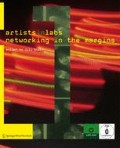Abstract
While working on a project concerned with theoretic models describing interrelations between higher cognitive and perceptual processes, I was kindly welcomed as a research fellow at laboratories of neurobiology — as an ‘art historian in lab’ one might say. While I was officially treated as a ‘visiting scholar’, it was quite clear that I was seen rather as a more or less exotic ‘guest’ than as a ‘collaborator’ in a strict sense. A different perspective onto a shared field of interest, for example disparate ideas about what ‘art’ might be and which kind of questions were interesting to ask when dealing with works of art, were some of the issues that lead to a difference in research objectives and hypotheses. And even though I had entered a fruitful cross-disciplinary exchange of ideas on certain problems, I discovered that I was simultaneously acting as a kind of ethnologist (trying out the limits of participant observation) (Geertz 1987). My attention was drawn to certain aspects of laboratory practice that did not appear to be of central concern to my hosts.
Preview
Unable to display preview. Download preview PDF.
References
Ars Electronica futurelab 2009, accessed 9 March 2010, 〈http://www.aec.at/futurelab_about_en.php〉.
Ars Electronica human nature 2009, accessed 9 March 2010, 〈http://www.aec.at/humannature>.
Bal, M 2002, Travelling concepts in the humanities: A rough guide, University of Toronto Press, Toronto.
Davis, D 1973, Art and the Future: A history-prophecy of the collaboration between science, technology and art, Praeger, New York.
Geertz, C 1987, ‘‘Aus der Perspektive des Eingeborenen’: Zum Problem ethnologischen Verstehens’ (1977), in C Geertz, Dichte Beschreibung: Beiträge zum Verstehen kultureller Systeme, Suhrkamp, Frankfurt/M, pp. 289–309.
Haglund, M 2005, ‘The air between the planets: on the audio and visual works of Carsten Nicolai’, in carsten nicolai: anti reflex (exhib. cat.), Schirn Kunsthalle, Frankfurt/M, pp. 24–38.
Ikegami, T & Hashimoto, T 1995, ‘Active mutation in self-reproducing networks of machines and tapes’, artificial life, vol. 2, no. 3, pp. 305–318.
Jones, C 2006, ‘The mediated sensorium’, in C Jones (ed.), Sensorium: Embodied experience, technology, and the contemporary art, MIT Press and MIT List Visual Arts Center, Cambridge/MA, London, pp. 5–49.
Latour, B 2004, ‘How to talk about the body? The normative dimension of science studies’, Body & Society, vol. 10, no. 2–3, pp. 205–229.
Latour, B 2005, ‘From Realpolitik to Dingpolitik or how to make things public’, in B Latour & P Weibel, Making things public: the atmospheres of democracy, MIT Press, Cambridge/MA, pp. 14–41.
Latour, B 2005, ‘Spinoza lecture II: the aesthetics of matters of concern’, in B Latour, What is the style of matters of concern? Van Gorcum, Amsterdam, pp. 26–50, accessed 9 March 2010, 〈http://www.bruno-latour.fr/articles/article/97-STYLE-MATTERS-CONCERN.pdf>.
Latour, B 2009, ‘Spheres and networks: two ways to reinterpret globalization’, a lecture at Harvard Graduated School of Design, Feb. 17, 2009, in Harvard Design Magazine, no. 30, pp. 1–2, accessed 9 March 2010, 〈http://www.bruno-latour.fr/articles/article/115-SPACE-HARVARD-09.pdf>.
Malina, R 2006, ‘Welcoming uncertainty: the strong case for coupling the contemporary arts to science and technology’, in J Scott (ed.), artists-in-labs: Processes of inquiry, Springer, Vienna/New York, pp. 15–23.
Nakaya, U 1954, Snow crystals: natural and artificial, Harvard University Press, Cambridge/MA.
NASA habitability and environmental factors division homepage 2009, accessed 9 March 2010, 〈http://hefd.jsc.nasa.gov>.
Nicolaus, F 1999, ‘Carsten Nicolai: Ich bin ein Mauerspringer’, art, no. 12, pp. 78–83.
Nicolai, C 2007, alva noto: XERROX vol. 1 (record envelope), rasternoton, Chemnitz.
Nicolai, C 2009, ‘Two and a Half Questions with Carsten Nicolai’, Headphone Commute, accessed 9 March 2010, 〈http://reviews.headphonecommute.com/2009/09/08/two-and-a-half-questions-with-carsten-nicolai>.
Obrist, HU 2002, ‘Hans Ulrich Obrist im Gespräch mit Carsten Nicolai’, in raster-noton (ed), Carsten Nicolai: auto pilot, Berlin, pp. 59–68.
Pesch, M 1998, ‘Mehr als Crossover — Techno, House und neue elektronische Musik in der aktuellen Kunst’, U Groos & M Müller (eds) Jahresring (Make it funky. Crossover zwischen Musik, Pop, Avantgarde und Kunst), no. 45, pp. 325–329.
Pesch, M 2009, ‘Transfer and transformation: strategies in the oeuvre of carsten nicolai’, parachute (électrosons/electrosounds), vol. 107, pp. 81–93 (and other essays in the same volume).
Rando, CM, Baggerman, SD, Duvall, LE & Martin, 2004, ‘Habitability in Space’, Human Factors and Ergonomics Society Annual Meeting Proceedings, Aerospace Systems, San Diego, CA, pp. 5–9.
Rheinberger, H-J 2001, Experimentalsysteme und epistemisch Dinge, Wallstein-Verlag, Göttingen.
Rheinberger, H-J 2007, ‘Über die Kunst, das Unbekannte zu erforschen’ (2006), in P Friese, G Boulboullé & S Witzgall (eds), Say it isn’t so: art trains its sights on natural sciences, Kehrer Verlag, Heidelberg, pp. 83–91.
Schröder, B 2007, ‘Immateriality and the ephemeral in the works of Carsten Nicolai’, in carsten nicolai: static fades (exhib. cat.), Haus Konstruktiv, Zurich, pp.143–145.
Shanken, EA 2006, ‘Artists in industry and the academy: collaborative research, interdisciplinary scholarship, and the interpretation of hybrid forms’, in J Scott (ed.), artists-in-labs: Processes of inquiry, Springer, Vienna/New York, (pp. 8–14).
Soto, JR 1994, ‘The rolsdddsf — fdsf e of scientific concepts in art’, Leonardo: Journal of the International Society for the Arts, Sciences and Technology, vol. 27, no. 3, pp. 227–230.
Stockhausen, K 1963, ‘Texte zur elektronischen und instrumentalen Musik’, Bd. 1, Aufsätze 1952–1962: zur Theorie des Komponierens, ‘Es geht aufwärts’, vol. 9, D Schnebel (ed.), DuMont Schauberg, Köln, pp. 391–512.
Turrell, J 1998, ‘Crater Spaces’, in James Turrell: The other horizon, (exhib. cat.) MAK, Wien, pp. 156–186.
Wahjudi, C 2001, ‘Carsten Nicolai: Systeme aus Klang und Bild’, Kunstforum International, Bd. 155 (Der gerissene Faden: Nichtlineare Techniken in der Kunst), pp. 222–224.
Zschocke, N 2006, Der irritierte Blick: Kunstrezeption und Aufmerksamkeit, Wilhelm Fink, München.
Zschocke, N 2007, ‘Kollaborieren und Plappern: Das Internet als Testfeld relationaler Ästhetik’, 31: Das Magazin des Instituts für Theorie der Gestaltung und Kunst (Paradoxien der Partizipation), December, no.10/11, pp. 77–84.
Editor information
Editors and Affiliations
Rights and permissions
Copyright information
© 2010 Springer-Verlag/Wien
About this chapter
Cite this chapter
Zschocke, N. (2010). Art and Science Research Teams? Some Arguments in Favour of a Culture of Dissent. In: Scott, J. (eds) Artists-in-Labs Networking in the Margins. Springer, Vienna. https://doi.org/10.1007/978-3-7091-0321-0_7
Download citation
DOI: https://doi.org/10.1007/978-3-7091-0321-0_7
Publisher Name: Springer, Vienna
Print ISBN: 978-3-7091-0320-3
Online ISBN: 978-3-7091-0321-0

